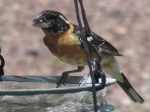It has been a busy two weeks with reader correspondence. The most common question has been “where have all the birds gone?” The answer, I think, is that they are migrating! At least many of them are. The Black-Headed Grosbeaks seem to leave in mid-August. I haven’t seen an American Robin in a while. But what about the Lesser Goldfinch? They are still here in Munds Park but not that active at our feeders. The theory: they are spending more time on the wild flower seeds from all the vegetation that has bloomed and now is going to seed. And the Western Bluebirds are abundant – one of the last to arrive in Munds Park and last to leave for fall migration.
On the other hand, the Canada Geese are sticking around and have been seen at the ponds of the Pinewood Country Club Golf Course. Also at the ponds was a new hatch of American Coots – must be the second brood of the season. At first the babies are black with red head feathers and a red beak – very cute! Then they turn into a boring gray before the distinctive black body and white beak.
Second question: What happened to the Osprey nest? This question came from my women golfer friends, who exhibited much concern since the Osprey nest, often with one or two birds on it, has been part of the landscape on the back nine of the golf course this summer and last summer. There were several theories: 1) the tree the nest was built on fell down of natural causes; 2) some terrible person cut down the tree because the Ospreys are loud, vocal birds and disturbed the human’s sleep; 3) the nest tumbled down on its own during the last very big storm, which seemed to be a micro-burst of rough weather. My friends and I concluded that the most likely answer is #3, primarily because we see one of the Osprey perched on a tall tree that we think was the exact one that held the nest. So the Ospreys are going back to a familiar place only to find that the house up and crashed, and they will have to build another next year. We all hope it will be in the same place so we can keep an eye on it in between our golf club swings.
Third question: Why don’t we have Magpies in Munds Park? The Black-Billed Magpie is a very large, noisy, black and white member of the jay family. I have seen them in Colorado when we visited Durango. The only part of Arizona they inhabit is the northeast corner of Apache Country – almost into Colorado. I did manage to find a scientific paper on Magpies in Arizona and concluded that probably temperature and humidity are the reasons they are not here. Probably a good thing, because the American Crows are noisy enough and I’m not sure we need another bird species to compete with them!
Lastly, a reader did say that she switched to nyger seeds and safflower seeds and the Brown-Headed Cowbirds went away and the Lesser Goldfinches returned. So that was a happy resolution to that dilemma.
